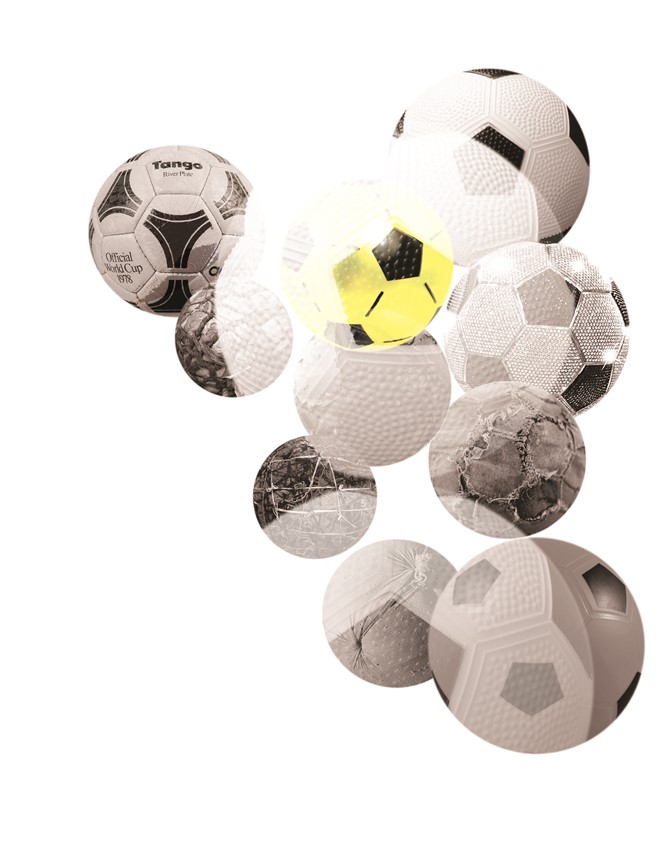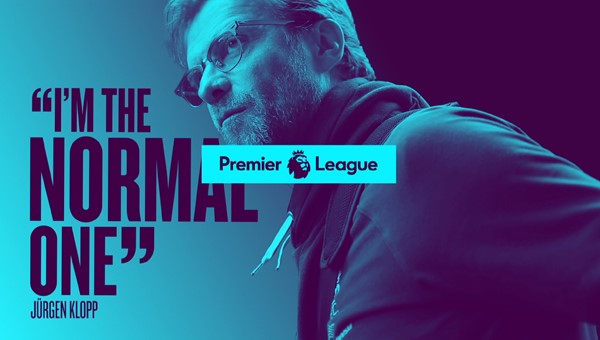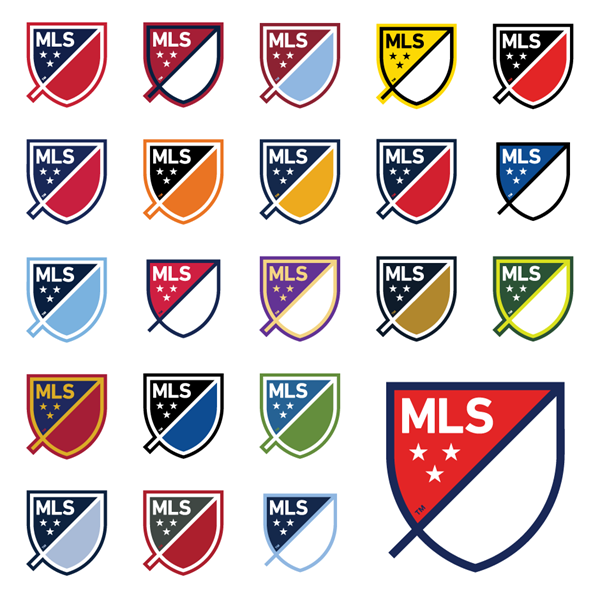Big leagues: Brand and reputation in the biggest sports on earth

The brand of a sports league can help build the reputation for the sport itself. How do leagues approach branding, licensing and business growth through design? Hassan Butt investigates
In 1988, the US’ successful bid to host the 1994 FIFA World Cup led to a surge of interest in a lucrative organised football league in North America, one that built on the struggles of the previously established North American Soccer League (NASL). By the end of 1993, Major League Soccer (MLS) was proposed as the antidote to America’s soccer obstacles. However, throughout its first decade, the league was largely considered a loss-making experiment, caught in a farrago of loose rule formatting and poor attendance, with no tangible means of replicating successful league structures such as those in the UK and Spain.
In 2007, MLS began exploring new avenues of expansion. Introducing a new league consideration entitled the ‘designated player rule,’ MLS teams would now be permitted to add a player whose value exceeded the team’s salary cap, instead being paid by the team owner and thus allowing the MLS to bid for international star players. Its first notable signing under the rule, David Beckham, agreed to a five-year deal with the Los Angeles Galaxy in 2007 with a guaranteed annual salary of $6.5m, almost 90% more than the salary cap allowance.
“We had to open up ourselves up to changing our wage structure, but also being able to attract people like Beckham. When we achieved that, it sent a signal. Branding is about sending signals, whether its corporations, the commercial community, the fan community or potential owners. When Beckham first came here, it sent a signal to other players around the world that this is a place that you can play and develop. As a result, we sit here years later, and there’s this whole world that now revolves around the MLS. We have some of the country’s most prolific civic and business leaders wanting to now invest in the league,” says David Bruce, head of branding at MLS.
Growing from 10 to 23 teams, Major League Soccer’s now-profitable model is decorated with the same progressive features as the world’s largest grossing sports leagues. Soccer-specific stadiums now hold crowd numbers that exceed that of the National Hockey League (NHL) and National Basketball Association (NBA), jersey-sponsors now include the likes of YouTube and Red Bull, and widespread TV coverage contributes to the league’s consistent profitability.
Yet in its entirety, the modern sports-media structure thrives on the persistence of brand, from licensing trademarked logos and the wider income-generation of intellectual property, to the vast swell of sponsorship. Yet in conjunction with much of the progressions of digital, sport now harnesses a dynamic approach to brand. Richer live experiences now eclipse the former glory of partner-provided hospitality packages, executives now look towards data to boost fan engagement, and as the global sports audience grows, branding tips the scales as its most prominent feature.
Along aesthetic lines, brand development in today’s sporting era has been subject to its own metamorphosis, one that paradoxically chases both idiosyncrasy and ubiquity. League identities, logos and team apparel have long formed the hallmark of the sporting tradition, and in many cases, have their roots firmly grounded in fan communities. Extensive research and quality-driven strategy is, in today’s sports landscape, paramount.
As the commercial value of sport brands increase due to the industry’s investment growth, so too do the challenges of branding within sports. Historically however, the collaborative engagement between both sports and branding began in a narrower context. Two of the US’ most memorable and lasting sports brands, the NBA and Major League Baseball (MLB), share a similar conception – the origin of the former, grew out of a need to refine the latter. Alan Siegel, president and CEO of global brand identity consultancy, Siegelvision, oversaw both projects as founder of Siegel+Gale.
“I started working with Major League Baseball to try to get together a 100-year anniversary symbol, a project that was run by the Yankees’ Mike Burke. I worked with him, trying to push for something that was a real breakthrough, that stood for the All-American game, used red, white and blue and had some dynamism to it, and some humanity too. The ‘batter’ symbol was approved immediately, and it’s been used ever since,” says Siegel.
Siegel’s own experience in sports branding has traced the entirety of the category’s design developments, overseeing an industry-wide departure from the archaic pen and ink, halftone illustrations of the early 1900s. Yet Siegel’s new brand aesthetic also reflected the rich cultural expression of sport. League expansions and cultural shifts saw global attitudes to sport widen, and as Siegel harnessed simplicity as a key theme, drawing upon perceptive and vivid design, the wider sports branding culture would soon follow suit.
He says, “I’m a former basketball player, and so when the NBA approached me with the desire to change its image, as well as the perception of the league, I reached out to a friend called Dick Schapp, editor of Sports Magazine. I went over and looked through his files and found this picture of [Los Angeles Lakers star] Jerry West. He was almost in an ‘S’ structure, his hips were off to the right, and he was dribbling the basketball. I used that picture as the NBA logo, and similarly, it was approved right away.”

“The most important thing is the fan. The thing that drives the work is the person that gets up every day and lives that sport, franchise, or hero – the community built around that sport”
While continuing to develop newer sports identities such as tennis’ US Open logo and the Big East US College basketball league, Siegel’s NBA and MLB logos have charted an enduring course, remaining both league’s lasting identities. Today, the NBA logo generates over $3bn in licencing each year. The MLB’s World Series, similarly, clocks a brand value that consistently exceeds $100bn, with teams such as the New York Yankees generating almost $4bn in franchise value each year.
However, not all branding endeavours strike the right chord. Team logos, as an example, are often a difficult element of a brand to alter. Heritage, culture and community, as with any established brand, often take precedence. The recent examples of football clubs Leeds United and Turin-based Juventus FC both provide interesting examples of difficulty when rethinking a sporting identity. Both teams have longstanding logos, possess a rich history and footballing culture, and welcome a dedicated, multigenerational fanbase. In early 2017, Juventus made the decision to update its brand, doing away with the crest-led culture of football identities and developing a new, imaginative brand that was built around a strategy of inclusion. Its principle design, developed by global branding agency, Interbrand, incorporated a simple, energetic identity while considering those further away from the sport. Despite being poorly received in its initial phase, Juventus’ wider following has since warmed to the rebrand.
A year later, Leeds United made a similar decision, incorporating over 10,000 fan consultations, six months of research and a wider community outreach to develop an innovative brand to commemorate the club’s upcoming centenary. Yet in Leeds’ case, its final product completely missed the mark, with fans criticising the logo’s overhaul and the design choices that were considered during the process. Responding to this, Leeds decided to reopen the consultation process, rescinding the logo and admitting to misfiring on its desired objectives.
Comparatively, the English Premier League (EPL) underwent its most radical rebrand to date in 2016, ridding itself for the first time of a title sponsor with the aim of shifting perceptions about both the sport and the game itself. Incorporating a minimalist strategy, San Francisco-based brand agency, Design Studio, worked on a completely distinctive colour profile, building a unique and flexible look that captured viewers through vivid and playful design. Developing transferable elements of the brand that could be repurposed and resized, the EPL’s new identity welcomed a dynamism that hadn’t previously existed, allowing the brand itself to become a mainstay for the global sport of football.
The challenge of translating the rebrand across to TV, whereby market share between Sky and BT consistently churn in as many as 800,000 viewers per match, represented a different challenge. London-based brand agency, DixonBaxi, was tasked with reinvigorating the Premier League’s TV experience.
Stretching the league’s visual expression – one that, in today’s broadcast setting, is increasingly multifaceted – DixonBaxi developed a motion graphic system that added an interactive element to the brand refresh, exemplified across the seamless melange of score cards, tables, photography and ‘field of play’ action. Gamifying the footballing experience, fans now see an enhanced television broadcast, one that incorporates augmented reality, reimagined design language and a greater visual depth to the sport.
“When Beckham first came here, it sent a signal to other players around the world that this is a place where you can
play and develop. As a result, we sit here years later, and there’s this whole world
that now revolves
around the MLS”

Further to DixonBaxi’s TV experience, the work was also immersed into EA Sports’ FIFA 2018, joining a collection of world broadcast designs that make up the entirety of the video game. DixonBaxi’s cross-sector experience creating digital experiences contributed to the building of its TV-specific project, subsequently allowing EA Sports to replicate its design.
Simon Dixon, co-founder of DixonBaxi, affirmed the importance of the viewer experience, which is often also the fan experience, throughout the project. “Fundamentally, this was going to be viewed around the world, with two or three billion people watching the Premier League at any given time. The way that the global audience connect with the brand, the football, the sport and the clubs themselves, is very different to the British context. We had permission to reevaluate everything, as though it were a blank canvas, and consider not only the international fan journey, but all of the brand assets, from action reels and photography to match graphics, and develop a better story,” says Dixon.
Yet for both Dixon and Siegel, tapping into the fan network is central to the development of a strong brand, as it often mirrors, and frequently surpasses, shareholder commitment. “The most important thing is the fan. The thing that drives the work is the person that gets up every day and lives that sport, franchise, or hero – the community built around that sport. There is a certain narrative to how fans engage with a sports fixture. There’s an authenticity that drives the design system, and if you don’t understand what the fan cares about, there’s no point in doing what you’re doing,” says Dixon.
The promotion of sports brands, from league logos to sponsor-driven campaigns, has given rise to a cornucopia of monitoring opportunities, creating insights into how brands can continue to capitalise on sports branding in today’s landscape. Founded in 2008, computer vision company, GumGum Sports, helps rights holders, sponsors and agencies measure and assess the real media value of their sponsorship across the omnichannel sports environment.
“In terms of how technology is going to change the sponsorship landscape, and how brands are going to address it, everything is data driven now. The rise of digital advertising itself is now targeted and trackable, and brands are now able to track what they’re doing. Yet the sports themselves, through things like VAR (Video Assistant Referees) in football and Hawkeye in tennis are changing the way the game is played, creating more controversial moments and greater brand value as a result,” says Sam Grimley, commercial director at GumGum Sports.
Yet as the value of sport brands increase, so too does the risk of losing that brand to the developing elements of the industry. Team crests, kits and wider marketing collateral can fall prey to the vast saturation of the wider sport-sponsorship entanglement. Despite its unrelenting growth, the need for sporting identities and brand strategies to grow in tandem with the progressions of the industry have become business-critical. Losing sight of this, can be costly.
Equally, the importance of heritage, nostalgia and consistency for the sports audience continues to remain relevant, and when tampered with, can breed discontent. For brand development however, striking a fine balance between the two need not be a tightrope walk, despite the apparent difficulties that remain tied to the industry. Overall, the sporting world is largely receptive to change. Too much however, and sports brands may find they lose sight of the goal.












